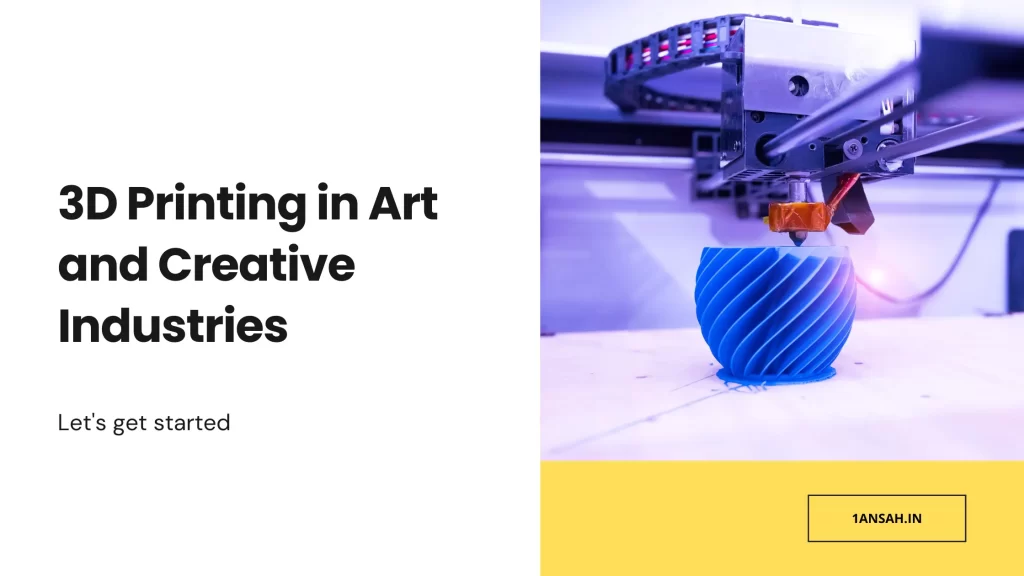3D printing has revolutionized the art and creative industries by providing artists and designers with unprecedented tools for innovation and expression. This transformative technology enables the creation of complex, intricate designs that were once impossible or extremely labor-intensive to achieve. From custom jewelry and fashion pieces to large-scale sculptures and interactive installations, 3D printing offers a new realm of possibilities for artistic creation. By allowing for rapid prototyping, customization, and experimentation with materials and forms, 3D printing is reshaping the boundaries of creativity, empowering artists to bring their most imaginative concepts to life with precision and efficiency.
Custom Jewelry Design with 3D Printing:
3D printing has revolutionized the jewelry industry by allowing designers to create intricate, customized pieces with precision and efficiency. Using advanced CAD software, jewelers can design unique items tailored to individual preferences, which are then brought to life through 3D printing. This technology enables the production of complex geometries that would be difficult or impossible to achieve with traditional methods. Additionally, 3D printing reduces material waste and production time, making it an environmentally friendly and cost-effective option for custom jewelry design.
Creating Sculptures Using 3D Printing Technology:
Artists are increasingly turning to 3D printing to create sculptures, benefiting from the technology’s ability to produce detailed and complex forms. 3D printing allows artists to experiment with new shapes and structures, pushing the boundaries of traditional sculpture. Digital sculpting tools enable the creation of highly detailed models, which can be printed in various materials, including plastics, resins, and metals. This method offers a new level of precision and reproducibility, allowing artists to bring their visions to life with unprecedented accuracy.
3D Printed Fashion and Wearable Art:
The fashion industry is embracing 3D printing to create avant-garde clothing and accessories that challenge conventional design norms. Designers can produce wearable art pieces that feature intricate patterns, textures, and structures not feasible with traditional manufacturing techniques. 3D printing also allows for the customization of garments to fit individual body shapes perfectly, enhancing both comfort and aesthetics. This technology promotes sustainability by enabling on-demand production and reducing fabric waste, aligning with the growing demand for eco-friendly fashion solutions.
Innovative Uses of 3D Printing in Film Props:
In the film industry, 3D printing is transforming the creation of props, allowing for rapid prototyping and production of highly detailed and customizable items. Filmmakers can design and print props that precisely match the artistic vision of a film, from futuristic gadgets to historical artifacts. This technology speeds up the production process and offers cost-effective solutions for creating multiple copies of props. 3D printing also enables the creation of lightweight and durable items, enhancing the practicality and realism of film props.
Architectural Models and Miniatures with 3D Printing:
Architects and designers utilize 3D printing to create detailed architectural models and miniatures that accurately represent their projects. This technology allows for the precise scaling of designs and the inclusion of intricate details that are crucial for client presentations and project planning. 3D printed models offer a tangible representation of architectural concepts, aiding in visualization and communication. Additionally, the ability to quickly produce and modify models enhances the iterative design process, making it more efficient and collaborative.
3D Printing for Set Design in Theater and Film:
3D printing is increasingly used in theater and film set design to create intricate and realistic environments. Designers can print detailed set pieces and props that enhance the visual storytelling of a production. This technology allows for the rapid prototyping and customization of set elements, ensuring they fit the specific needs of a scene. 3D printing also enables the creation of lightweight, durable, and cost-effective set components, reducing production time and costs while maintaining high aesthetic standards.
Personalized Home Décor Items with 3D Printing:
Home décor enthusiasts are leveraging 3D printing to create personalized items that reflect their unique style and preferences. From custom furniture and lighting fixtures to decorative accessories, 3D printing allows for the creation of bespoke pieces that enhance the individuality of home interiors. This technology enables the production of complex designs and textures, offering endless possibilities for creativity.
3D Printing for Interactive Art Installations:
Interactive art installations are being revolutionized by 3D printing, which allows artists to create dynamic and engaging pieces that interact with viewers. 3D printing can produce components with precise dimensions and intricate details, enabling the creation of interactive elements such as moving parts, sensors, and lights. This technology fosters innovation in art, allowing artists to explore new forms of expression and audience engagement.
Digital Fabrication of Musical Instruments:
3D printing is making waves in the world of musical instrument fabrication, offering new possibilities for customization and innovation. Designers can create instruments with unique shapes, sizes, and acoustic properties that cater to specific musical preferences and performance needs. 3D printing allows for the precise production of complex geometries, enhancing the sound quality and playability of instruments. This technology also supports the creation of lightweight and durable instruments, making them more accessible and portable for musicians.
3D Printing in Contemporary Art Exhibitions:
Contemporary art exhibitions are showcasing the creative potential of 3D printing, with artists using the technology to produce groundbreaking works. 3D printed art pieces demonstrate the versatility and innovation of this medium, challenging traditional artistic boundaries. Exhibitions featuring 3D printed art highlight the intersection of technology and creativity, offering audiences a glimpse into the future of artistic expression. These exhibitions inspire dialogue about the impact of digital fabrication on art and culture, celebrating the fusion of technology and aesthetics.
Customizable Artwork with 3D Printing:
3D printing enables the creation of customizable artwork that can be tailored to individual tastes and preferences. Artists can design modular pieces that allow for personalization in terms of size, color, and form. This customization extends to functional art, such as furniture and lighting, where users can specify dimensions and features to suit their needs. 3D printing democratizes art by making bespoke pieces more accessible and affordable, allowing more people to enjoy personalized artistic expressions in their homes and workplaces.
Replicating Historical Artifacts Using 3D Printing:
Museums and historians are using 3D printing to replicate historical artifacts, preserving and sharing cultural heritage. 3D scanning and printing technologies enable the creation of accurate replicas of fragile or rare artifacts, allowing for their display and study without risking damage to the originals. These replicas can be used in educational settings, exhibitions, and research, providing wider access to historical artifacts. 3D printing also supports restoration efforts by creating precise parts needed for the conservation of damaged artifacts.
Using 3D Printing for Ceramics and Pottery:
Ceramic artists are embracing 3D printing to create intricate pottery and ceramic pieces with precision and creativity. 3D printing allows for the exploration of complex shapes, textures, and patterns that are difficult to achieve with traditional handcrafting techniques. Artists can design and print molds or directly print ceramic pieces using specialized 3D printers and materials. This technology expands the possibilities for ceramic art, enabling artists to push the boundaries of their craft and experiment with new forms and finishes.
3D Printed Molds for Casting and Sculpting:
3D printed molds are transforming casting and sculpting practices by offering precise and customizable templates for artists. These molds can be designed digitally and printed in various materials, providing a flexible and efficient solution for producing detailed casts. 3D printing allows for the rapid creation of molds with intricate patterns and textures, enhancing the quality and complexity of cast sculptures.
Exploring New Textures and Forms in Art with 3D Printing:
Artists are using 3D printing to explore new textures and forms, pushing the boundaries of traditional art techniques. 3D printing allows for the creation of intricate surface textures and complex geometries that are difficult to achieve manually. This technology enables artists to experiment with innovative designs and materials, resulting in unique and visually striking art pieces. 3D printing fosters creativity by providing a platform for artists to explore new artistic expressions and challenge conventional aesthetics.
Collaborations between Artists and Engineers:
Collaborations between artists and engineers are fostering innovation in 3D printing art, combining technical expertise with creative vision. Engineers provide the technical knowledge needed to design and execute complex 3D printed projects, while artists bring creative concepts and aesthetic sensibilities. These collaborations result in groundbreaking works that leverage the strengths of both disciplines, pushing the boundaries of what is possible with 3D printing.
3D Printing in Animation and Stop-Motion Films:
3D printing is revolutionizing animation and stop-motion films by enabling the creation of detailed and customizable characters, props, and sets. Filmmakers can design and print intricate models that enhance the visual storytelling of their films. 3D printing allows for the rapid prototyping and iteration of animation components, streamlining the production process and reducing costs. This technology supports the creation of highly detailed and expressive characters, bringing animation projects to life with precision and creativity.
Sustainable Art Practices with 3D Printing:
3D printing supports sustainable art practices by promoting the use of eco-friendly materials and reducing waste. Artists can use biodegradable or recycled materials for their 3D printed projects, minimizing their environmental impact. 3D printing also enables on-demand production, reducing the need for mass production and excess inventory. By adopting sustainable practices, artists contribute to environmental conservation and promote awareness of sustainability issues through their work.
Educational Art Projects Involving 3D Printing:
Educational institutions are incorporating 3D printing into art projects, providing students with hands-on experience in digital fabrication. 3D printing fosters creativity, problem-solving, and technical skills, offering students a valuable tool for artistic expression and innovation. Educational projects involving 3D printing allow students to explore new artistic techniques, experiment with materials, and bring their ideas to life. By integrating 3D printing into art education, schools prepare students for future careers in the creative industries and promote interdisciplinary learning.
The Role of 3D Printing in Digital and Mixed Media Art:
3D printing plays a significant role in digital and mixed media art, enabling artists to combine traditional and digital techniques in innovative ways. Artists can integrate 3D printed elements into their mixed media projects, creating multidimensional and interactive artworks. 3D printing enhances the versatility of mixed media art, allowing for the exploration of new textures, forms, and materials. This technology supports the creation of dynamic and immersive art pieces that engage audiences and push the boundaries of artistic expression.
The integration of 3D printing into the art and creative industries marks a significant milestone in the evolution of artistic expression. This technology not only enhances the creative process but also democratizes it, making it accessible to a broader range of artists and designers. As 3D printing continues to advance, we can expect to see even more innovative applications and groundbreaking works of art that challenge conventional norms and push the limits of what is possible. Ultimately, 3D printing is not just a tool but a catalyst for a new era of creativity, where the only limit is the artist’s imagination.

